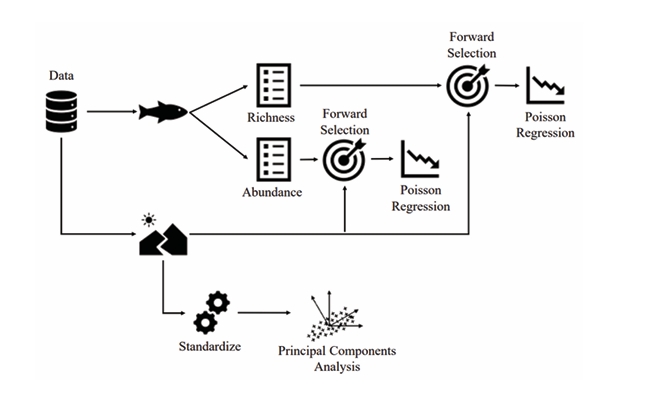Fishes from tributaries of the Itacaiúnas river
DOI:
https://doi.org/10.37002/biodiversidadebrasileira.v15i1.2683Palavras-chave:
Stream , diversity , monitoringResumo
Anthropogenic activities in the Amazon region have an impact on the aquatic environment and, consequently, on the organisms that live there. The lack of knowledge about the ecological relationships of the fish community in the region, as well as their relationship with the environmental variables that determine their survival and distribution, leads to a loss of data for ecological studies and biomonitoring. The objective of our study was to evaluate how environmental variables influence the richness and abundance of fish species in tributaries of the Itacaiúnas river, Pará, Brazil. Therefore, we tested the hypothesis that the richness and abundance of these communities vary according to the variation of physical and chemical parameters in these streams. The study was carried out in 16 streams in the Carajás National Forest, with collections of the fish community, measurements of physical and chemical variables in the water and channel morphology. To synthesize the environmental variables, we used a Principal Components Analysis. We related environmental variables to species richness and individual abundance using forward selection regression with Poisson distribution. The results show that environmental variables influence the richness and abundance of the fish community as they are related to habitat availability, food, life cycle, trophic relationships and water quality. These results highlight the importance of water quality, particularly turbidity, which had the greatest influence on the condition of these aquatic communities, providing valuable information for future conservation and monitoring strategies.
Downloads
Referências
[1] Rezende CF. Estrutura da comunidade de macroinvertebrados associados ao folhiço submerso de remanso e correnteza em igarapés da Amazônia Central. Biota Neotrop 2007;7:301–5. https://doi.org/10.1590/S1676-06032007000200034. DOI: https://doi.org/10.1590/S1676-06032007000200034
[2] Moritz C, Patton JL, Schneider CJ, Smith TB. Diversification of Rainforest Faunas: An Integrated Molecular Approach. Annu Rev Ecol Syst 2000;31:533–63. https://doi.org/10.1146/annurev.ecolsys.31.1.533. DOI: https://doi.org/10.1146/annurev.ecolsys.31.1.533
[3] Barbosa HDO, De Souza MF, Ondei LDS, Teresa FB. CONHECIMENTO ECOLÓGICO LOCAL E PERCEPÇÃO DOS IMPACTOS AMBIENTAIS POR MORADORES DA ZONA RURAL SOBRE RIACHOS E PEIXES DA BACIA DO ALTO RIO TOCANTINS, GOIÁS, BRASIL. Ethnoscientia 2017;2. https://doi.org/10.22276/ethnoscientia.v2i1.63. DOI: https://doi.org/10.22276/ethnoscientia.v2i1.63
[4] ICMBio. Plano de Manejo da Floresta Nacional de Carajás. Instituto Chico Mendes de Conservação Da Biodiversidade 2016.
[5] Medeiros R, Young CE. Contribuição das unidades de conservação brasileiras para a economia nacional: relatório final. 2011.
[6] Gabriel FÂ, Hauser-Davis RA, Soares L, Mazzuco ACA, Rocha RCC, Saint Pierre TD, et al. Contamination and oxidative stress biomarkers in estuarine fish following a mine tailing disaster. PeerJ 2020;8:e10266. https://doi.org/10.7717/peerj.10266. DOI: https://doi.org/10.7717/peerj.10266
[7] Freitas P V., Montag LFA, Ilha P, Torres NR, Maia C, Deegan L, et al. Local effects of deforestation on stream fish assemblages in the amazon-savannah transitional area. Neotropical Ichthyology 2021;19. https://doi.org/10.1590/1982-0224-2021-0098. DOI: https://doi.org/10.1590/1982-0224-2021-0098
[8] Fitriyyah I, Firdaus MY, Kusumorini A, Taufiq R, Akbar M, Biologi S, et al. Diversity of Fish Species as Bioindicators of Water Quality in The Cikapundung River, Bandung City 2024. https://doi.org/10.29303/jbt.v24i3.7009. DOI: https://doi.org/10.29303/jbt.v24i3.7009
[9] Freitas CEC, Siqueira-Souza FK. O uso de peixes como bioindicador ambiental em áreas de várzea da bacia amazônica. Revista Agrogeoambiental 2009;1. https://doi.org/10.18406/2316-1817v1n2200975. DOI: https://doi.org/10.18406/2316-1817v1n2200975
[10] Araújo FG. Adaptação do índice de integridade biótica usando a comunidade de peixes para o rio Paraíba do Sul. Rev Bras Biol 1998;58:547–58. https://doi.org/10.1590/S0034-71081998000400002. DOI: https://doi.org/10.1590/S0034-71081998000400002
[11] Chovanec A, Hofer R, Schiemer F. Chapter 18 Fish as bioindicators, 2003, p. 639–76. https://doi.org/10.1016/S0927-5215(03)80148-0. DOI: https://doi.org/10.1016/S0927-5215(03)80148-0
[12] Angermeier PL. Fish Conservation: A Guide to Understanding and Restoring Global Aquatic Biodiversity and Fishery Resources. J North Am Benthol Soc 2008;27:802–4. https://doi.org/10.1899/0887-3593(2008)27[802:br]2.0.co;2. DOI: https://doi.org/10.1899/0887-3593(2008)27[802:BR]2.0.CO;2
[13] Casatti L. Alterações no Código Florestal Brasileiro: impactos potenciais sobre a ictiofauna. Biota Neotrop 2010;10:31–4. https://doi.org/10.1590/S1676-06032010000400002. DOI: https://doi.org/10.1590/S1676-06032010000400002
[14] Dias RR, Paradella WR. Integração de dados aéreos gamaespectrométricos com imagens TM-Landsat no mapeamento geológico da área do Pojuca, província mineral de Carajás. Revista Brasileira de Geofísica 1997;15:23–34. https://doi.org/10.1590/S0102-261X1997000100003. DOI: https://doi.org/10.1590/S0102-261X1997000100003
[15] Rolim SG, Couto HTZ do, Jesus RM de, França JT. Modelos volumétricos para a Floresta Nacional do Tapirapé-Aquirí, Serra dos Carajás (PA). Acta Amazon 2006;36:107–14. https://doi.org/10.1590/S0044-59672006000100013. DOI: https://doi.org/10.1590/S0044-59672006000100013
[16] Queiroz L, Torrente-Vilara G, Ohara W, Pires T, Zuanon J, Doria C. Peixes do Rio Madeira. 2013.
[17] Sleen P, Albert JS. Field Guide Amazon Orinoco & Guianas. 2017.
[18] Peck D V, Herlihy AT, Colina BH, Hughes RM, Kaufmann PR, Klemm D, et al. Environmental monitoring and assessment program-surface waters western pilot study: Field operations manual for wadeable streams. EPA/620/R-06/003. Washington, D.C: U. S Environmental Protection Agency. Office of Research and Development ; 2006.
[19] Junqueira NT, Macedo DR, Souza RCR de, Hughes RM, Callisto M, Pompeu PS. Influence of environmental variables on stream fish fauna at multiple spatial scales. Neotropical Ichthyology 2016;14. https://doi.org/10.1590/1982-0224-20150116. DOI: https://doi.org/10.1590/1982-0224-20150116
[20] Osmundson DB, Ryel RJ, Lamarra VL, Pitlick J. Flow-Sediment-Biota Relations: Implications for River Regulation Effects on Native Fish Abundance. Ecological Applications 2002;12:1719. https://doi.org/10.2307/3099934. DOI: https://doi.org/10.2307/3099934
[21] Fernandes IM, Sacoman K de J, Farias-Neto JP de, Silva HP da, Vendruscolo J, Lourenço L da S. Effect of environmental and spatial factors on small-sized fish assemblages in a tropical river. Acta Amazon 2021;51:129–38. https://doi.org/10.1590/1809-4392202002303. DOI: https://doi.org/10.1590/1809-4392202002303
[22] Lunt J, Smee DL. Turbidity alters estuarine biodiversity and species composition. ICES Journal of Marine Science 2020;77:379–87. https://doi.org/10.1093/icesjms/fsz214. DOI: https://doi.org/10.1093/icesjms/fsz214
[23] Stuart-Smith RD, Stuart-Smith JF, White RWG, Barmuta LA. The effects of turbidity and complex habitats on the feeding of a galaxiid fish are clear and simple. Mar Freshw Res 2007;58:429. https://doi.org/10.1071/MF06240. DOI: https://doi.org/10.1071/MF06240
[24] Odum EP, Finn JT, Franz EH. Perturbation Theory and the Subsidy-Stress Gradient. Bioscience 1979;29:349–52. https://doi.org/10.2307/1307690. DOI: https://doi.org/10.2307/1307690
[25] Bogotá-Gregory JD, Lima FCT, Correa SB, Silva-Oliveira C, Jenkins DG, Ribeiro FR, et al. Biogeochemical water type influences community composition, species richness, and biomass in megadiverse Amazonian fish assemblages. Sci Rep 2020;10:15349. https://doi.org/10.1038/s41598-020-72349-0. DOI: https://doi.org/10.1038/s41598-020-72349-0
[26] Brejão GL, Hoeinghaus DJ, Pérez‐Mayorga MA, Ferraz SFB, Casatti L. Threshold responses of Amazonian stream fishes to timing and extent of deforestation. Conservation Biology 2018;32:860–71. https://doi.org/10.1111/cobi.13061. DOI: https://doi.org/10.1111/cobi.13061
[27] Pott CM, Dala-Corte RB, Becker FG. Body size responses to land use in stream fish: the importance of different metrics and functional groups. Neotropical Ichthyology 2021;19. https://doi.org/10.1590/1982-0224-2021-0004. DOI: https://doi.org/10.1590/1982-0224-2021-0004
[28] Connell JH. Diversity in Tropical Rain Forests and Coral Reefs. Science (1979) 1978;199:1302–10. https://doi.org/10.1126/science.199.4335.1302. DOI: https://doi.org/10.1126/science.199.4335.1302
[29] Mueller JS, Grabowski TB, Brewer SK, Worthington TA. Effects of Temperature, Total Dissolved Solids, and Total Suspended Solids on Survival and Development Rate of Larval Arkansas River Shiner. J Fish Wildl Manag 2017;8:79–88. https://doi.org/10.3996/112015-JFWM-111. DOI: https://doi.org/10.3996/112015-JFWM-111
[30] Ortega JCG, Figueiredo BRS, da Graça WJ, Agostinho AA, Bini LM. Negative effect of turbidity on prey capture for both visual and non‐visual aquatic predators. Journal of Animal Ecology 2020;89:2427–39. https://doi.org/10.1111/1365-2656.13329. DOI: https://doi.org/10.1111/1365-2656.13329
[31] Ferreira C de P, Casatti L. Influência da estrutura do hábitat sobre a ictiofauna de um riacho em uma micro-bacia de pastagem, São Paulo, Brasil. Rev Bras Zool 2006;23:642–51. https://doi.org/10.1590/S0101-81752006000300006. DOI: https://doi.org/10.1590/S0101-81752006000300006

Downloads
Publicado
Edição
Seção
Licença
Copyright (c) 2025 Os autores mantêm os direitos autorais de seus artigos sem restrições, concedendo ao editor direitos de publicação não exclusivos.

Este trabalho está licenciado sob uma licença Creative Commons Attribution-NonCommercial-NoDerivatives 4.0 International License.
Os artigos estão licenciados sob uma licença Creative Commons Atribuição-NãoComercial-SemDerivações 4.0 Internacional (CC BY-NC-ND 4.0). O acesso é livre e gratuito para download e leitura, ou seja, é permitido copiar e redistribuir o material em qualquer mídia ou formato.











